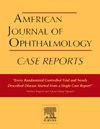土著危地马拉-玛雅裔儿童患泰-萨克斯病,伴有黄斑棕色斑点和凹周白斑
Q3 Medicine
引用次数: 0
摘要
目的:本报告描述了一个不寻常的黄斑表现的泰-萨克斯病在一个两岁的女性危地马拉-玛雅血统。本病例是建立在非常有限的文献关于泰-萨克斯病在非高加索人群的眼部表现。观察患者及家属表现为视力差、听觉亢进。眼底检查发现双眼黄斑斑疹周围发白。实验室研究显示低己糖氨酸酶A水平,这证实了泰-萨克斯病的诊断。结论和重要性:这是一例极其罕见的泰-萨克斯病,发生在危地马拉-玛雅血统的患者中,通过酶研究和眼底检查确诊。此外,与经典的“樱桃红点”相反,这是与Tay-Sachs病有关的少数记录在案的“棕色斑点”之一。本病例对“樱桃红点”的命名提出了挑战,以解释可能发生在不同种族和民族的泰-萨克斯病患者眼底的变化。本文章由计算机程序翻译,如有差异,请以英文原文为准。
Tay-Sachs disease in a child of indigenous Guatemalan-Mayan origin with macular brown spots and perifoveal whitening
Purpose
This report describes an unusual macular presentation of Tay-Sachs disease in a two-year-old female of Guatemalan-Mayan origin. This case serves to build upon the very limited literature regarding ophthalmic manifestations of Tay-Sachs disease in the non-Caucasian population.
Observations
The patient and family presented with concern for poor visual acuity and hyperacusis. A brown macular spot with perifoveal whitening was identified in both eyes on fundus examination. Laboratory studies revealed low hexosaminidase A levels, which confirmed the diagnosis of Tay-Sachs disease.
Conclusions and importance
This is an extremely rare case of Tay-Sachs disease in a patient of Guatemalan-Mayan origin diagnosed by enzyme studies and fundus examination. Further, it is one of the few documented cases of “brown spots” appreciated in association with Tay-Sachs disease, as opposed to the classic “cherry red spot”. This case presentation challenges the nomenclature of the “cherry red spot” to account for the variations in the fundus that may occur in different racial and ethnic groups that present with Tay-Sachs disease.
求助全文
通过发布文献求助,成功后即可免费获取论文全文。
去求助
来源期刊

American Journal of Ophthalmology Case Reports
Medicine-Ophthalmology
CiteScore
2.40
自引率
0.00%
发文量
513
审稿时长
16 weeks
期刊介绍:
The American Journal of Ophthalmology Case Reports is a peer-reviewed, scientific publication that welcomes the submission of original, previously unpublished case report manuscripts directed to ophthalmologists and visual science specialists. The cases shall be challenging and stimulating but shall also be presented in an educational format to engage the readers as if they are working alongside with the caring clinician scientists to manage the patients. Submissions shall be clear, concise, and well-documented reports. Brief reports and case series submissions on specific themes are also very welcome.
 求助内容:
求助内容: 应助结果提醒方式:
应助结果提醒方式:


